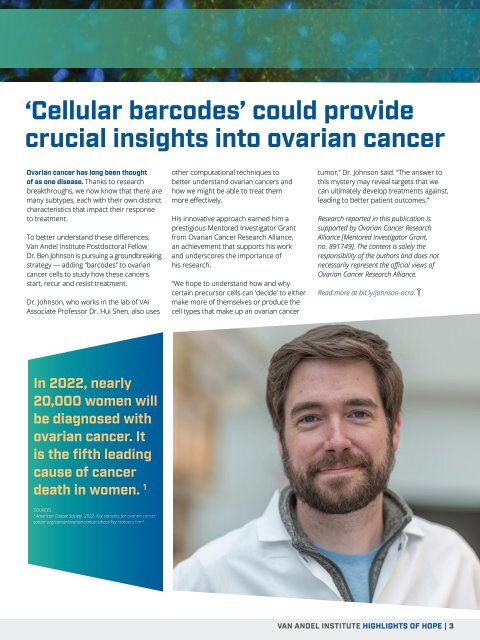2022 Fall/Winter Highlights of Hope
This is the 2022 Fall/Winter edition of Van Andel Institute's Highlights of Hope donor publication.
This is the 2022 Fall/Winter edition of Van Andel Institute's Highlights of Hope donor publication.
You also want an ePaper? Increase the reach of your titles
YUMPU automatically turns print PDFs into web optimized ePapers that Google loves.
‘Cellular barcodes’ could provide<br />
crucial insights into ovarian cancer<br />
Ovarian cancer has long been thought<br />
<strong>of</strong> as one disease. Thanks to research<br />
breakthroughs, we now know that there are<br />
many subtypes, each with their own distinct<br />
characteristics that impact their response<br />
to treatment.<br />
To better understand these differences,<br />
Van Andel Institute Postdoctoral Fellow<br />
Dr. Ben Johnson is pursuing a groundbreaking<br />
strategy — adding “barcodes” to ovarian<br />
cancer cells to study how these cancers<br />
start, recur and resist treatment.<br />
Dr. Johnson, who works in the lab <strong>of</strong> VAI<br />
Associate Pr<strong>of</strong>essor Dr. Hui Shen, also uses<br />
other computational techniques to<br />
better understand ovarian cancers and<br />
how we might be able to treat them<br />
more effectively.<br />
His innovative approach earned him a<br />
prestigious Mentored Investigator Grant<br />
from Ovarian Cancer Research Alliance,<br />
an achievement that supports his work<br />
and underscores the importance <strong>of</strong><br />
his research.<br />
“We hope to understand how and why<br />
certain precursor cells can ‘decide’ to either<br />
make more <strong>of</strong> themselves or produce the<br />
cell types that make up an ovarian cancer<br />
tumor,” Dr. Johnson said. “The answer to<br />
this mystery may reveal targets that we<br />
can ultimately develop treatments against,<br />
leading to better patient outcomes.”<br />
Research reported in this publication is<br />
supported by Ovarian Cancer Research<br />
Alliance [Mentored Investigator Grant,<br />
no. 891749]. The content is solely the<br />
responsibility <strong>of</strong> the authors and does not<br />
necessarily represent the <strong>of</strong>ficial views <strong>of</strong><br />
Ovarian Cancer Research Alliance.<br />
Read more at bit.ly/johnson-ocra.<br />
In <strong>2022</strong>, nearly<br />
20,000 women will<br />
be diagnosed with<br />
ovarian cancer. It<br />
is the fifth leading<br />
cause <strong>of</strong> cancer<br />
death in women. 1<br />
SOURCES<br />
1<br />
American Cancer Society. <strong>2022</strong>. Key statistics for ovarian cancer.<br />
cancer.org/cancer/ovarian-cancer/about/key-statistics.html<br />
VAN ANDEL INSTITUTE HIGHLIGHTS OF HOPE | 3















